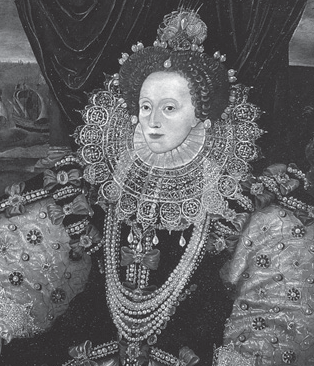Elizabeth I (1533–1603) was the queen of England who defeated the Spanish armada, sponsored the first English explorations of the New World, and presided over the renaissance of English literature and drama known as the Elizabethan Age. She also ended the English religious wars of the mid-sixteenth century by firmly establishing Protestantism as the dominant religion of England.

The daughter of Henry VIII (1491–1547), Elizabeth never expected to become monarch. Her mother, Henry’s second wife, Anne Boleyn (c. 1507–1536), had been beheaded for adultery and incest after failing to give birth to a male heir, and Elizabeth had been declared retroactively illegitimate after her mother’s execution.
Instead, her younger half-brother, Edward VI (1537–1553), became king after Henry’s death. When Edward died, another half-sibling, Mary (1516–1558), took the throne. Mary was a Roman Catholic, and she attempted to reverse the Protestant reforms enacted by her father and half-brother and restore Catholicism as the official religion.
During Mary’s reign, leading Protestant clerics were executed, and Elizabeth was imprisoned for her Protestant sympathies. Still, Mary named Elizabeth her heir, and the young princess became queen in 1558, at age twenty-five.
One of Elizabeth’s first acts was to pass a bill through Parliament that reestablished Protestantism as the official religion. In foreign affairs, one of Elizabeth’s most significant accomplishments was defeating the massive Spanish naval fleet that tried to invade England in 1588.
Playwrights and poets of the Elizabethan Age included William Shakespeare (1564–1616), Christopher Marlowe (1564–1593), and Edmund Spenser (c. 1552–1599), whose best-known poem, The Faerie Queene, celebrated Elizabeth’s rule.
Elizabeth never married, and after her death at age sixty-nine, she was succeeded by a cousin, King James VI (1566–1625) of Scotland—who became James I of England.
ADDITIONAL FACTS
- Elizabeth spurned numerous suitors during her reign, including King Philip II of Spain (1527–1598), Mary’s widower, and the Duke of Anjou (1554–1584), who was heir to the French throne.
- Many actresses have portrayed Elizabeth on film, including Cate Blanchett (1969–), Judi Dench (1934–), and Bette Davis (1908–1989).
- The famous ocean liner Queen Elizabeth 2 was named after Elizabeth I, not her twentieth-century relative, Queen Elizabeth II (1926–). The confusion is due to the fact that the vessel was the second to be named after Elizabeth I—thus the numeral 2 in its name.
